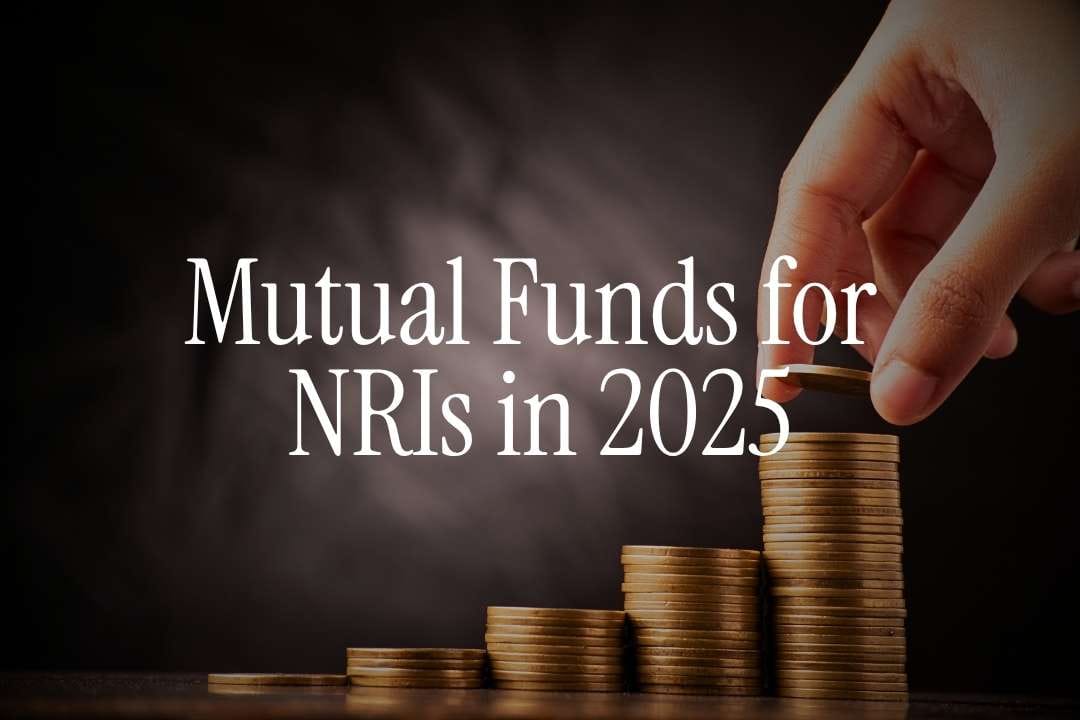
Looking to invest in Indian mutual funds from Dubai or Abu Dhabi? You're probably juggling time zones, wondering about tax implications, and frustrated with conflicting information from different banks and advisors.
I get it - I've helped thousands of NRIs navigate this exact confusion over my 12 years in fintech.
Here's the reality: Indian mutual funds delivered average returns of 12-15% annually over the past decade, but most NRIs either miss out entirely or make costly mistakes with compliance.
This guide cuts through the noise and gives you everything - tax rules, best funds, online processes, repatriation methods, and those hidden catches nobody talks about.
The Real Challenge NRIs Face with Indian Mutual Funds
Most NRIs discover the hard way that their resident Indian demat account doesn't work anymore. Banks give incomplete information.
Online platforms reject applications. Meanwhile, the Sensex keeps climbing, and you're stuck on the sidelines watching opportunities pass by.
The complexity isn't accidental. Different regulations apply based on whether you're in the UAE, US, or UK. Your money source matters (foreign earnings vs Indian income). Even the type of NRI account you hold changes everything.
👉 Tip: Before investing a single rupee, first determine your residential status correctly. RNOR status offers significant tax advantages for the first 2 years after becoming an NRI.
Why Indian Mutual Funds Still Make Sense for NRIs in 2025
Despite the hurdles, mutual funds remain the smartest entry point into Indian markets for NRIs. Unlike direct stocks that need constant monitoring during IST trading hours (when you're probably in office in Dubai), mutual funds work on autopilot.
Professional fund managers handle the complexity. You get instant diversification across 50-100 stocks with just ₹5,000.
Most importantly, systematic investment plans (SIPs) let you invest monthly without timing the market - crucial when you're earning in AED or USD and worried about rupee fluctuations.
The numbers speak volumes: even conservative debt funds delivered 7-8% returns, beating NRI FD rates by 2-3%.
Equity funds? The top performers crossed 20% annually. Compare that to your 2% savings account in the UAE.
Complete Mutual Fund Landscape for NRIs
Types of Funds You Can Actually Invest In
Not all mutual funds accept NRI money. Here's what's available:
Equity Funds
Open to all NRIs. Large-cap funds offer stability (HDFC Top 100, ICICI Bluechip), while mid-cap funds provide growth potential. Sectoral funds exist but require careful monitoring.
Debt Funds
Perfect for conservative NRIs. Corporate bond funds, gilt funds, and liquid funds all accept NRI investments. Returns range from 6-9% with lower volatility than equity.
Hybrid Funds
Balanced advantage funds automatically adjust equity-debt allocation. Ideal if you can't actively manage your portfolio from abroad.
Funds NRIs Cannot Touch
Infrastructure debt funds, certain close-ended schemes, and some arbitrage funds restrict NRI participation. Always check the scheme information document (SID) before investing.
👉 Tip: Stick to growth options over dividend options. Dividend taxation for NRIs is higher at 20% TDS compared to capital gains.
The Tax Reality Check Every NRI Must Understand
Short-Term vs Long-Term Capital Gains
Hold equity funds for over 12 months, and your gains qualify as long-term. Tax rate: 12.5% on gains above ₹1.25 lakh. Sell before 12 months? You'll pay 20% on short-term gains.
Debt funds work differently. Long-term applies after 36 months, taxed at 20% with indexation benefit. Short-term gains get added to your income and taxed per slab rates - could go up to 30%.
TDS Complications and How to Minimize Them
AMCs deduct TDS at source - 20% for short-term equity gains, 12.5% for long-term equity gains (plus surcharge and cess). But here's what most advisors won't tell you: DTAA benefits can reduce this significantly.
For UAE-based NRIs, the India-UAE tax treaty limits capital gains tax to 12.5%. You'll need to submit Form 15CA/15CB to claim treaty benefits. Yes, it's paperwork, but it saves thousands.
Which Mutual Fund Companies Accept NRI Investments?
Not every AMC rolls out the red carpet for NRIs. Based on my testing in 2025, here's the real situation:
Table: AMC Comparison for NRI Investors
AMC Name | Online for UAE NRIs | US/Canada NRIs | Minimum Investment |
|---|---|---|---|
HDFC Mutual Fund | ✅ Full online | ✅ With restrictions | ₹5,000 |
ICICI Prudential | ✅ Full online | ✅ With restrictions | ₹5,000 |
SBI Mutual Fund | ⚠️ Partial online | ✅ Accepted | ₹5,000 |
Axis Mutual Fund | ✅ Full online | ❌ Not accepted | ₹5,000 |
Kotak Mutual Fund | ✅ Full online | ❌ Not accepted | ₹10,000 |
Aditya Birla | ⚠️ Offline only | ✅ With restrictions | ₹1,000 |
American and Canadian NRIs face extra restrictions due to FATCA compliance. Only 10 out of 44 AMCs accept their investments, often requiring physical forms and embassy attestations.
👉 Tip: Open your NRI account online with banks that have tie-ups with multiple AMCs. ICICI and HDFC offer the widest mutual fund access.
Step-by-Step Process: From Zero to First Investment
Step 1: Get Your NRI Banking Ready
You need either an NRE or NRO account. Can't decide which? Simple rule: Use NRE for foreign earnings (tax-free, fully repatriable). Use NRO for Indian income (rent, pension, dividends).
Most UAE NRIs maintain both. Your Dubai salary goes to NRE; your Bangalore rental income sits in NRO. Each serves different investment purposes.
Step 2: The KYC Marathon
Here's where things get tricky. Regular KYC doesn't work anymore - you need NRI KYC. The process differs from the resident Indian version:
- Download KYC form from any KRA website (CAMS, Karvy, NDML)
- Self-attest your passport copy, overseas address proof, PAN card
- Get documents attested by: Indian embassy, bank manager, or gazetted officer
- Submit physically or through authorized representatives in India
- In-person verification recently became optional for amounts under ₹50,000 annually. But most NRIs invest more, triggering IPV requirements.
Step 3: Choose Your Investment Route
Direct Plans via AMC Websites
Lower expense ratios (save 1-1.5% annually). But you'll manage multiple logins, track different portfolios, handle your own rebalancing.
MF Utilities Platform
Single platform for multiple AMCs. Good for managing diverse portfolios. However, not all funds available, and the interface feels dated.
Broker Platforms (Zerodha, Groww)
User-friendly apps, consolidated reporting, easy switching between funds. Downside? They might push regular plans with higher fees.
Step 4: Making Your First Transaction
Choose growth option over dividend (tax efficiency). Start with large-cap funds or index funds - boring but safe. Set up SIP mandates from your NRE/NRO account.
For lump sum investments above ₹10 lakhs, use STP (Systematic Transfer Plan). Park money in liquid funds first, then transfer gradually to equity funds over 3-6 months.
👉 Tip: Always invest through the same bank account linked during KYC. Mismatched accounts cause rejection, forcing you to restart the process.
Advanced Strategies for Smart NRI Investors
Asset Allocation for Currency Hedging
Your salary comes in AED/USD, but investments are in INR. Currency risk is real - rupee depreciation can enhance returns when you repatriate, but appreciation hurts.
Smart allocation: Keep 60% in Indian equity funds (rupee exposure), 20% in international funds (dollar hedge), 20% in debt funds (stability). Adjust based on your return timeline.
Tax Harvesting Techniques
Book losses strategically to offset gains. If a fund is down 10% in March, sell and immediately buy a similar fund. You've crystallized the loss for tax purposes while maintaining market exposure.
Similarly, book partial profits every year just under ₹1.25 lakh to use the tax-free limit for long-term capital gains.
The Power of Direct Plans
A 1.5% expense ratio difference between regular and direct plans compounds dramatically. On ₹50 lakh invested over 10 years, you save nearly ₹8 lakhs. Yet 70% of NRIs invest in regular plans because advisors don't mention direct options.
Hidden Costs and Risks Nobody Discusses
NRI account hidden charges extend to mutual funds too. Watch for:
Exit Loads
Most equity funds charge 1% if you withdraw within one year. Some debt funds have exit loads up to 3 years. Always check before investing.
Transaction Charges
Brokers charge ₹100-150 per SIP transaction for regular plans. Over 10 years, that's ₹15,000 in just transaction fees.
Currency Conversion Spreads
Banks make money on forex conversion. The difference between card rate and wire transfer rate can be 1-2%. On large investments, negotiate better rates.
Repatriation Charges
Moving money back involves: capital gains tax, bank charges (₹500-5,000), wire transfer fees ($25-50), and receiving bank charges. Factor these into return calculations.
Special Considerations for US and Canadian NRIs
The FATCA Compliance Nightmare
American NRIs must report mutual fund holdings on Form 8938 if total foreign assets exceed $200,000 (married filing jointly) or $50,000 (single). Indian mutual funds qualify as Passive Foreign Investment Companies (PFICs), triggering complex tax reporting.
Each fund needs separate PFIC calculations. Many US-based NRIs skip mutual funds entirely due to compliance costs exceeding investment gains on smaller portfolios.
Limited AMC Options
Only these AMCs currently accept US/Canada-based NRIs:
- Aditya Birla Sun Life
- SBI Mutual Fund
- L&T Mutual Fund
- UTI Mutual Fund
- PPFAS Mutual Fund
- Sundaram Mutual Fund
Even these require physical documentation, embassy attestations, and offline transactions only. No online SIPs allowed - you'll make manual purchases each time.
👉 Tip: US/Canadian NRIs should explore GIFT City investment options which offer similar returns with simpler compliance.
The GIFT City Alternative: Easier Path for NRIs
Frustrated with traditional mutual fund complications? GIFT City offers a parallel solution. GIFT City funds work differently:
- Invest in USD (no rupee conversion needed)
- Zero capital gains tax
- 100% repatriation allowed
- Simplified KYC process
- No FATCA reporting complications
Currently, 15 mutual funds operate in GIFT City, including equity, debt, and hybrid options. Returns are comparable to domestic funds but in dollar terms.
The catch? Minimum investments are higher ($10,000 for most funds), and choice remains limited compared to domestic options.
Common Mistakes That Cost NRIs Lakhs
Not Updating Residential Status
Continuing investments with resident status after becoming NRI violates FEMA regulations. Penalties range from ₹10,000 to 3x the investment amount.
Ignoring Indexation Benefits
Debt fund gains qualify for indexation after 36 months, reducing effective tax to 6-8%. Many NRIs sell early, paying 30% tax instead.
Over-Diversification
Holding 15-20 funds doesn't reduce risk - it guarantees mediocre returns. Most NRIs need just 4-5 well-chosen funds across categories.
Chasing Past Performance
Last year's best fund often becomes next year's worst. Focus on consistent performers over 5-7 year periods, not recent champions.
Stopping SIPs During Market Corrections
Market crashes are when SIPs work best - you buy more units at lower prices. NRIs who stopped SIPs in March 2020 missed the 100% recovery rally.
Repatriation: Getting Your Money Back
Repatriating funds from India requires proper documentation:
- Form 15CA/15CB: Chartered accountant certificate confirming tax compliance
- Capital Gains Statement: From the mutual fund house
- Bank Certificate: Confirming investment source (NRE/NRO)
- Tax Residency Certificate: If claiming DTAA benefits
NRE-source investments freely repatriate after paying applicable taxes. NRO-source investments face the $1 million annual limit, including principal and gains.
Processing takes 7-10 working days. Banks charge 0.125% to 0.5% of the amount, minimum ₹500. Add another $25-40 for SWIFT charges.
👉 Tip: Repatriate in chunks below $25,000 to avoid additional reporting requirements in many countries.
Top Mutual Fund Picks for NRIs in 2025
Based on consistency, NRI-friendliness, and online accessibility:
Conservative NRIs (Debt-Heavy)
- ICICI Prudential Corporate Bond Fund
- HDFC Banking & PSU Debt Fund
- Axis Treasury Advantage Fund
Balanced Investors
- HDFC Balanced Advantage Fund
- ICICI Prudential Equity & Debt Fund
- Kotak Debt Hybrid Fund
Growth Seekers (Equity-Focused)
- Mirae Asset Large Cap Fund
- Axis Bluechip Fund
- Parag Parikh Flexi Cap Fund
Index Fund Believers
- UTI Nifty 50 Index Fund
- HDFC Index Fund - NIFTY 50 Plan
- ICICI Prudential Nifty Next 50 Index Fund
Remember: Past performance doesn't guarantee future returns. Diversify across fund houses and review annually.
Conclusion
Investing in Indian mutual funds as an NRI isn't as simple as your bank relationship manager suggests. You need the right account type, proper KYC, tax planning, and realistic expectations about costs and compliance.
Here's what you now know:
- NRE accounts work best for foreign earnings; NRO for Indian income
- KYC requires physical documentation and possible in-person verification
- Direct plans save 1.5% annually over regular plans
- US/Canadian NRIs face severe restrictions; only 10 AMCs accept them
- Tax rates vary from 12.5% to 30% based on fund type and holding period
- GIFT City offers an alternative with dollar investments and zero tax
- Repatriation needs proper documentation but is straightforward with planning
Your next step depends on your situation. Ready to start? Open an NRI account online with a bank offering good mutual fund access. Want to skip the complexity? Explore GIFT City investment options through Belong.
Whatever you choose, don't let perfect become the enemy of good. Starting with a simple index fund SIP beats waiting for the "perfect" investment strategy.
Need to file taxes in India as an NRI?
We got you covered. Checkout NRI Tax Filing Service by Belong.





